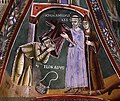Novalesa Abbey

Novalesa Abbey (
Novalesa is in the Val di Susa, on the route to the Mont Cenis Pass, and on the former Via Francigena, a major pilgrimage road.[2] The abbey is still in operation as an active Benedictine monastery.[3]
History


The abbey was officially founded in a position commanding the

The first phase of the abbey's history, abbot Eldrado's era, came to an end when it was destroyed by Saracen raiders in 906.[6][7] Most monks moved to Turin, while others moved to Lomellina (in southern Lombardy) where they founded the monastery of Breme.
The abbey was rebuilt in the early 11th century by Gezo, abbot of Breme according to the Chronicon Novaliciense. In 1646 the Benedictines were replaced by Cistercian monks, who remained here until 1796, when they were expelled by the Piedmontese provisional government. A third refoundation occurred after the monks of a hospital established by Napoleon at the Mont Cenis (1802) moved back to Novalesa after the emperor's fall. However, they were again expelled in 1855 and the abbey's building auctioned under the laws of expropriation of the Piedmontese government. The complex was acquired by the province of Turin in 1972 and was revived in 1973 with the return of the Benedictine monks, who still live there.[8]
Description
The complex of Novalesa includes a monastic building proper, and the abbey church.


The abbey is accessed through a portal leading to a first court, with a three-span portico with groin vaults, surmounted by a loggia. There is another court around which the building revolves: at its center are the two remaining wings of the 16th century cloister: one has five and the other has seven round arcades, supported by cylindrical columns without capitals. At the crossing between the two cloister wings is the bell tower, built in 1725-1730, which stands at 22.50 metres (73.8 ft).[9] The abbey church is dedicated to Sts. Peter and Paul. It was built in the 18th century above the pre-existing
, built in 1725.Chapels in the monastery area
Around the monastery are four chapels: one dedicated to Mary (8th century, restored in the 11th century), one to the Holy Saviour (mid-11th century), one to St. Michael (8th-9th centuries) and one to St. Eldradus. The latter houses a fresco cycle from the late 11th century, depicting stories of the life of St. Eldradus and St. Nicholas. It's one of the first known Nicholas's frescoes in continental Europe.
-
Chapel of Sant'Eldrado
-
Chapel of Santa Maria
-
Chapel of Santa Maria
-
Chapel of San Michele
-
Chapel of San Michele
-
Chapel of San Salvatore
Fresco cycle of St. Eldradus
-
Christ Pantocrator
-
St. Eldradus and St. Nicholas
-
St. Eldradus enters the abbey
-
Life of St. Eldradus
See also
Notes
- ^ Piemontefeel - MUSEI
- ^ Abbazia di Novalesa - abbey Turin Building Tiscover
- ^ Montagnedoc - Culture - Abbeys - Novalesa Abbey
- ^ Cipolla, pp. 1-13. Lord Abbo was also generous to the monastery in his Testament, a copy of which is also preserved in Turin.
- ^ Savorie, Provence and Alps Carolingian Visitor's Guide, Carolingian sites, French feudal coins
- ^ The Italian Cities and the Arabs before 1095, Hilmar C. Krueger, A History of the Crusades: The First Hundred Years, Vol.I, ed. Kenneth Meyer Setton, Marshall W. Baldwin, (University of Pennsylvania Press, 1955), 51.
- ^ "In Italy Online - La Via Francigena In The "Valley Of The Abbeys". Archived from the original on 2008-03-23. Retrieved 2008-02-01.
- ^ Segusium, Numero speciale su Novalesa e la sua Abbazia, Dicembre 1973, Anno X, n. 10.
- ^ "Il campanile". Novalesa official website. Retrieved 4 June 2013.
Books
- Carlo Cipolla, ed. (1898). Monumenta novaliciensia vetustiora: raccolta degli atti e delle cronache riguardanti l'abbazia della Novalesa (in Italian and Latin). Vol. Tomo I. Forzani e c., tip. del Senato.
External links
- Official website (in Italian)










